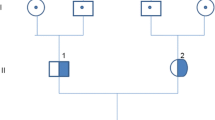Abstract
Herein, we describe the case of an 8-year-old boy who presented with a nephritic nephrotic syndrome. His laboratory investigation was significant for a persistently low serum complement 3 level. A renal biopsy was performed, based on which, he was diagnosed with dense deposit disease/membranoproliferative glomerulonephritis type II (DDD/MPGN II). He was treated with alternate-day oral corticosteroids, angiotensin-converting enzyme (ACE) inhibitors and tacrolimus. Factor H mutational analysis showed the Y402H and I62V allele polymorphisms. The purpose of our report is to discuss the association of the H402 allele variant of factor H with the DDD/MPGN II phenotype and its possible therapeutic implications.





Similar content being viewed by others
References
Covic A, Schiller A, Volovat C, Gluhovschi G, Gusbeth-Tatomir P, Petrica L, et al. Epidemiology of renal disease in Romania: a 10 year review of two regional renal biopsy databases. Nephrol Dial Transplant 2006;21:419–24.
Appel GB, Cook HT, Hageman G, Jennette JC, Kashgarian M, Kirschfink M, et al. Membranoproliferative glomerulonephritis type II (dense deposit disease): an update. J Am Soc Nephrol 2005;16:1392–403.
Duvall-Young J, MacDonald MK, McKechnie NM. Fundus changes in (type II) mesangiocapillary glomerulonephritis simulating drusen: a histopathological report. Br J Ophthalmol 1989;73:297–302.
Aita K, Ito S, Tanabe K, Toma H, Yamaguchi Y, Nagata M. Early recurrence of dense deposit disease with marked endocapillary proliferation after renal transplantation. Pathol Int 2006;56:101–9.
West CD, Witte DP, McAdams AJ. Composition of nephritic factor-generated glomerular deposits in membranoproliferative glomerulonephritis type 2. Am J Kidney Dis 2001;37:1120–30.
Habib R, Kleinknecht C, Gubler M-C, Levy M. Idiopathic membranoproliferative glomerulonephritis in children. Report of 105 cases. Clin Nephrol 1973;1:194–214.
Klein M, Poucell S, Arbus GS, McGraw M, Rance CP, Yoon SJ, et al. Characteristics of a benign subtype of dense deposit disease: comparison with the progressive form of this disease. Clin Nephrol 1983;20:163–71.
Ikeda M, Honda M, Hasegawa O. Another example of spontaneous improvement in a case of dense deposit disease. Pediatr Nephrol 2001;16:609–10.
Marks SD, Rees L. Spontaneous clinical improvement in dense deposit disease. Pediatr Nephrol 2000;14:322–4.
Cameron JS, Turner DR, Heaton J, Williams DG, Ogg CS, Chantler C, et al. Idiopathic mesangiocapillary glomerulonephritis. Comparison of types I and II in children and adults and long-term prognosis. Am J Med 1983;74:175–92.
West CD. Childhood membranoproliferative glomerulonephritis: an approach to management. Kidney Int 1986;29:1077–93.
McEnery PT, McAdams AJ, West CD. The effect of prednisone in a high-dose, alternate-day regimen on the natural history of idiopathic membranoproliferative glomerulonephritis. Medicine (Baltimore) 1985;64:401–24.
McEnery PT, McAdams AJ. Regression of membranoproliferative glomerulonephritis type II (dense deposit disease): observations in six children. Am J Kidney Dis 1988;12:138–46.
Donadio JV Jr, Offord KP. Reassessment of treatment results in membranoproliferative glomerulonephritis, with emphasis on life-table analysis. Am J Kidney Dis 1989;14:445–51.
Tarshish P, Bernstein J, Tobin JN, Edelmann CM Jr. Treatment of mesangiocapillary glomerulonephritis with alternate-day prednisone—a report of the International Study of Kidney Disease in Children. Pediatr Nephrol 1992;6:123–30.
Cattran DC, Cardella CJ, Roscoe JM, Charron RC, Rance PC, Ritchie SM, et al. Results of a controlled drug trial in membranoproliferative glomerulonephritis. Kidney Int 1985;27:436–41.
Kurtz KA, Schlueter AJ. Management of membranoproliferative glomerulonephritis type II with plasmapheresis. J Clin Apher 2002;17:135–7.
Haddad M, Lau K, Butani L. Remission of membranoproliferative glomerulonephritis type I with the use of tacrolimus. Pediatr Nephrol 2007;22:1787–91.
Høgåsen K, Jansen JH, Mollnes TE, Hovdenes J, Harboe M. Hereditary porcine membranoproliferative glomerulonephritis type II is caused by factor H deficiency. J Clin Invest 1995;95:1054–61.
Pickering MC, Cook HT, Warren J, Bygrave AE, Moss J, Walport MJ, et al. Uncontrolled C3 activation causes membranoproliferative glomerulonephritis in mice deficient in complement factor H. Nat Genet 2002;31:424–8.
Habib R, Gubler M-C, Loirat C, Maïz HB, Levy M. Dense deposit disease: a variant of membranoproliferative glomerulonephritis. Kidney Int 1975;7:204–15.
West CD. Nephritic factors predispose to chronic glomerulonephritis. Am J Kidney Dis 1994;24:956–63.
Daha MR, van Es LA. Further evidence for the antibody nature of C3 nephritic factor (C3NeF). J Immunol 1979;123:755–8.
Hegasy GA, Manuelian T, Høgåsen K, Jansen JH, Zipfel PF. The molecular basis for hereditary porcine membranoproliferative glomerulonephritis type II: point mutations in the factor H coding sequence block protein secretion. Am J Pathol 2002;161:2027–34.
Licht C, Heinen S, Józsi M, Löschmann I, Saunders RE, Perkins SJ, et al. Deletion of Lys224 in regulatory domain 4 of factor H reveals a novel pathomechanism for dense deposit disease (MPGN II). Kidney Int 2006;70:42–50.
Abrera-Abeleda MA, Nishimura C, Smith JL, Sethi S, McRae JL, Murphy BF, et al. Variations in the complement regulatory genes factor H (CFH) and factor H related 5 (CFHR5) are associated with membranoproliferative glomerulonephritis type II (dense deposit disease). J Med Genet 2006;43:582–9.
Prosser E, Johnson S, Roversi P, Herbert AP, Blaum BS, Tyrrell J, et al. Structural basis for complement factor H linked age-related macular degeneration. J Exp Med 2007;204:2277–83.
Licht C, Weyersberg A, Heinen S, Stapenhorst L, Devenge J, Beck B, et al. Successful plasma therapy for atypical hemolytic uremic syndrome caused by factor H deficiency owing to a novel mutation in the complement cofactor protein domain 15. Am J Kidney Dis 2005;45:415–21.
Smith RJ, Alexander J, Barlow PN, Botto M, Cassavant TL, Cook HT, et al. New approaches to the treatment of dense deposit disease. J Am Soc Nephrol 2007;18:2447–56.
Hong Y, Zhou W, Li K, Sacks SH. Triptolide is a potent suppressant of C3, CD40 and B7h expression in activated human proximal tubular epithelial cells. Kidney Int 2002;62:1291–300.
Author information
Authors and Affiliations
Corresponding author
About this article
Cite this article
Lau, K.K., Smith, R.J., Kolbeck, P.C. et al. Dense deposit disease and the factor H H402 allele. Clin Exp Nephrol 12, 228–232 (2008). https://doi.org/10.1007/s10157-008-0031-z
Received:
Accepted:
Published:
Issue Date:
DOI: https://doi.org/10.1007/s10157-008-0031-z




